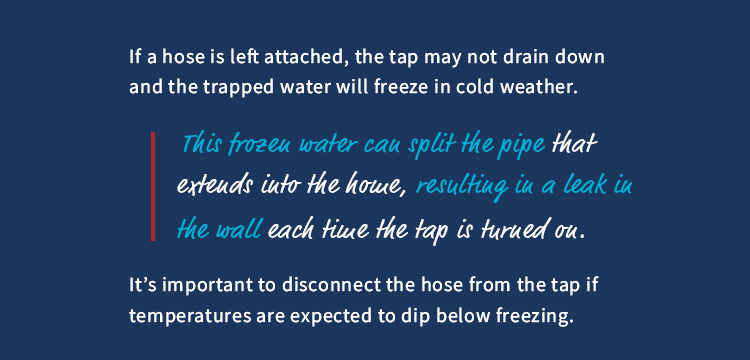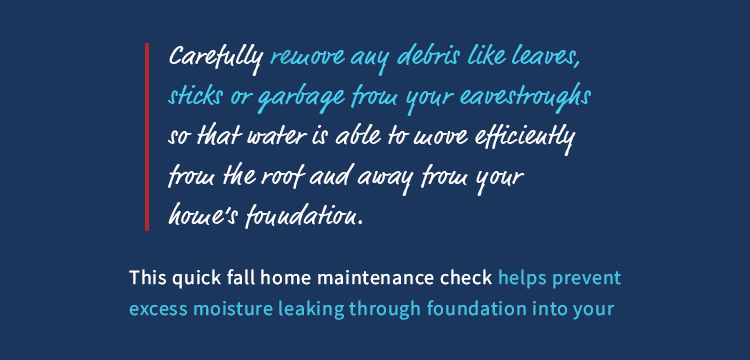Last Updated on February 24, 2021
Keep Track Of Fall Home Maintenance With Our Free Checklist
This easy-to-follow printable Fall Home Maintenance Checklist is the essential guide for homeowners living in Alberta. Learn from our expert team of home builders as they share their essential fall home maintenance tips to schedule this October or November.
The leaves are turning from green to orange, you’ve dusted off your favourite chili recipe and pulled out your warm sweaters. Fall is in the air and as any homeowner knows, it’s the perfect time to complete some important home maintenance.
1. Check Caulking and Weather Stripping
First up on our fall home maintenance checklist is a thorough check of the caulking sealing your home’s windows and doors to ensure the caulking and weather stripping is in good repair.
Notice a gap or some loose caulking?
Plan a trip to your local hardware store to pick up some caulking and DIY the fix or look into hiring a professional.
2. Clean Your Humidifier
Ensuring your home’s humidifier is clean and in good repair is key as mineral deposits can otherwise build up and cause damage or clog the humidifier.
To clean your humidifier, a number of simple anti-scaling products can be purchased from any hardware store and applied easily.
For the remainder of the autumn season, the relative humidity of your home should be set to around 40 percent.
3. Drain Exterior Water Lines
Ensuring the hose connected to the outside of your home is disconnected in the fall is an important step in ensuring your home stays in good repair.
If a hose is left attached, the tap may not drain down and the trapped water will freeze in cold weather. This frozen water can split the pipe that extends into the home, resulting in a leak in the wall each time the tap is turned on. It’s important to disconnect a hose from the tap if temperatures are expected to dip below freezing.

4. Drain Sediment in Hot Water Tank
Sediment that accumulates at the bottom of the tank (especially with immersion-type elements) can cause the heaters to operate longer than necessary, which increases your energy consumption.
In order to ensure your hot water tank is running efficiently all winter long, the tank should be flushed regularly in accordance with the manufacturer’s directions.
Related Video: How to Operate and Maintain Your Hot Water Tank The Right Way
5. Fertilize Your Lawn
As many other green thumbs know, the fall is one of the most important seasons of the year when it comes to lawn maintenance.
Start by raking up any loose leaves and picking up pine cones and any other debris.
To ensure your grass stays healthy and boasts a bright green colour come spring, be sure to cut your grass down to between 2 to 3 inches height and apply a winter fertilizer that’s high in potassium.
6. Winterize Your Landscaping
Applying mulch around your trees, plants and shrubs helps to add extra protection for winter. Mulching is an important control for erosion and loss of water.
Wrap any delicate shrubs and hedges, and protect your plants and trees from rabbits & deer.
7. Check Carbon Monoxide and Smoke Detectors
A safe home is a happy home.
A quick test of your CO2 and smoke detectors will give you peace of mind, and allow you to ensure they’re working properly. Check your batteries during your check and change when necessary.
8. Clean Range Hood and Over the Range Microwave Filters
Grease and fats build up in the filter as you cook and it is important to clean or change them monthly.
9. Check for Soil Settlement at Foundation
As we head into the winter months, ensuring that the grade slope around your foundation, and home are positive is incredibly important.
Check to make sure that no soil has settled near the foundation of your home, and if it has, correct it right away by topping the soil up, re-creating the positive grade.
10. Water Your Trees and Shrubs
Protect your plans from October and November’s freezing temperatures by keeping soil moist around your home during dry, cold weather.
Simply put, water is a great natural insulator.
Try to establish a regular watering schedule through the fall months as moist soil tends to stay warmer than dry soil.
Not only will it help your soil, but plant cells that are plump with water will also be stronger against cold damage.

11. Inspect Eavestroughs and Downspouts
Fall showers and early winter’s bouts of melting snow can lead to significant water volumes.
Carefully remove any debris like leaves, sticks or garbage from your eavestroughs so that water is able to move efficiently from the roof and away from your home’s foundation.
This quick fall home maintenance check helps prevent excess moisture leaking through foundation into your basement.
12. Check Basement Teleposts
Into the basement we go for our next set of checks.
Check your steel teleposts after the summer months to ensure that no settling has happened. If settling has occurred, simply tighten the post or call in a professional to take care of it for you.
13. Inspect Floor Drains
A home’s floor drains are typically located next to the furnace and work to help remove water spilled on the basement floor.
To prevent sewer gas from entering your home through floor drains, it’s essential to make sure there is always water present in the drains.
For a simple test to determine whether or not your drains have water in them, pour a small amount of water into the drain and listen. If you hear the water hit more water, you’re in good shape. If the water you pour into the drain sounds like it is hitting the bottom of the trap, your system could use a top up.
Every few months or if you smell sewer gas, pour a bucket of water down the drain to re-establish the water seal.
14. Check Furnace and Ventilation System Filters
To keep your ventilation systems operating efficiently, clean or replace filters as necessary and keep outdoor intake vents clear of obstructions.
Some new homes have whole-home ventilation systems which ensure a balanced intake and exhaust of air, airborne pollutants and moisture. These are usually box-like units which contain filters, a heat exchanger, a motor and supply and exhaust ducting. Balanced ventilation systems warm incoming air with some of the heat that would otherwise be lost, increasing a home’s efficiency.
Related Video: How to Easily Maintain Your Home Ventilation Systems
15. Check for Condensation and Humidity
Check windows, mirrors and vertical glass surfaces for condensation.
If you notice a build up of moisture or water vapour in your home’s air, the humidity levels in your home are too high; a dehumidifier offers a quick and easy fix.
If you notice increased static electricity, dry skin or chapped lips, these are a telltale sign that your humidity levels are too low. Increase the relative humidity in your home with your humidifier to re-establish balance.
16. Balance Air Flow at Heating Ducts
Each heat register in your home has a damper.
If an area of your home is too cool or too warm, you can adjust the dampers to reduce or increase the airflow into the area.
This is known as balancing your system and is especially important for registers located near your home’s thermostat.
17. Clean Your Furnace Filter
A dirty or plugged furnace filter can limit air flow from the furnace to the ducts; this makes your furnace work harder, and your power cost more.
Inspect and clean or replace the furnace air filter at the beginning of the heating season and on a regular basis throughout the winter months to ensure your HVAC system is operating efficiently.
Are you ready to complete your fall maintenance? Download our free checklist today!
More Home Maintenance
7 Simple Steps to Cleaning & Maintaining Your Home’s Heat Recovery Ventilator (HRV)
Lincolnberg Master Builder has been proudly building homes in Edmonton and area for over 41+ years. Learn more about us or browse our home models today.